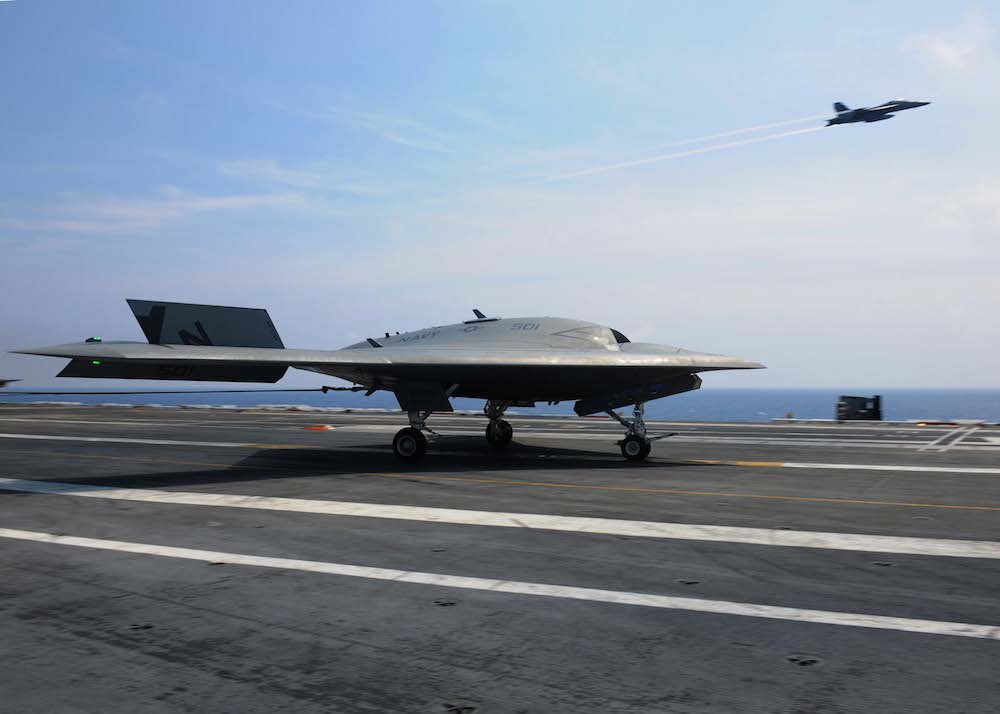Fighter Jets and Drones Practice Rapid-Fire Launches

The U.S. Navy recently conducted its first successful tests of drones and jets operating together aboard an aircraft carrier. The test flights, which took place Sunday (Aug. 17) aboard the USS Theodore Roosevelt, focused on assessing whether unmanned drones could be deployed quickly and safely alongside manned fighter jets.
Despite tight space and time constraints, the X-47B drones and the F/A-18 Super Hornet fighter jets performed well in the tests, according to the U.S. Navy.
In urgent situations, fighter jets must take off and land in quick succession. That means that when one jet is taking off, another is close behind it, shielded from the blast of the first jet's engines by huge metal shields called "jet blast deflectors," according to online defense magazine Breaking Defense. As soon as one jet takes to the air, these metal walls are retracted and the next jet taxis onto the aircraft carrier's catapult. [7 Technologies That Transformed Warfare]
When landing to refuel, a jet must automatically disconnect from the cables that help it come to a stop. This makes it possible for an aircraft to get out of the way quickly so that another jet can land behind it.
For manned aircraft, the Navy has the precise timing needed to deploy a whole squadron of fighter jets down to science. But in the past, getting a drone to fall into this hectic rhythm has been a challenge, according to Breaking Defense.
"Our goal was to minimize the [X-47B's] time in the landing area and improve the flow with manned aircraft in the landing pattern," said Lt. Cmdr. Brian Hall, the flight test director for the X-47B drones. Hall said that to achieve this goal, the X-47B aircraft, which flew for the first time in 2011, needed a few upgrades.
Most of the X-47B's improvements focused on decreasing the time it takes for the drone to get out of the way of piloted aircraft after landing on the aircraft carrier. This is no easy feat, since a drone has only about 90 seconds to clear the landing area before another aircraft comes speeding down behind it.
Sign up for the Live Science daily newsletter now
Get the world’s most fascinating discoveries delivered straight to your inbox.
For the recent test flights, the drone's operating software was updated, thus speeding up the time it takes for the aircraft to fold its wings and clear the landing area. Other improvements to the physical design of the plane also help move the drone out of the way as quickly as possible.
Getting drones and jetsto work seamlessly and safely together is crucial to the success of the Navy's so-called carrier air wings — naval aviation units comprising aircraft carriers and the different kinds of aircraft they carry — said Capt. Beau Duarte, program manager for the Navy's unmanned carrier aviation office.
"Today, we showed that the X-47B could take off, land and fly in the carrier pattern with manned aircraft while maintaining normal flight-deck operations," Duarte said.
This type of cooperation between drones and jets will be tested several more times, according to a statement from the U.S. Navy. The next challenge includes performing all of these same tasks in the dark of night— a procedure known as "night deck handling."
Follow Elizabeth Palermo @techEpalermo. Follow Live Science @livescience, Facebook & Google+. Original article on Live Science.

Elizabeth is a former Live Science associate editor and current director of audience development at the Chamber of Commerce. She graduated with a bachelor of arts degree from George Washington University. Elizabeth has traveled throughout the Americas, studying political systems and indigenous cultures and teaching English to students of all ages.









